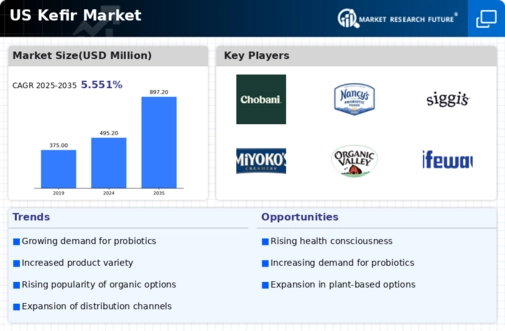The competitive landscape of the US Kefir Market has become increasingly vibrant in recent years, driven by a growing consumer interest in health and wellness products. This rising demand for fermented foods has led to the emergence of diverse brands that cater to varying dietary preferences, with kefir being recognized for its probiotic benefits and nutritional value. As consumers become more health-conscious and inclined towards natural food options, the market continues to evolve, incorporating both traditional and innovative approaches.
Companies are focusing on enhancing their product offerings, which includes various flavors, organic options, and even dairy-free alternatives, to capture a wider audience. This intense competition fosters a dynamic environment where brands must continuously innovate while also addressing consumer preferences for convenience, taste, and nutritional content.Stonyfield Organic has carved out a strong place in the US Kefir Market due to its commitment to organic farming and sustainability.
The company leverages its brand heritage by promoting its organic credentials along with the health benefits of its kefir products, which appeal to environmentally aware consumers. Stonyfield Organic emphasizes quality in its production processes, utilizing high-quality organic ingredients, which strengthens its positioning as a trusted choice among health-conscious customers. In addition to its strong brand identity, Stonyfield benefits from an extensive distribution network that spans grocery chains, natural food stores, and online platforms, allowing for widespread access to its kefir products.
The company's reputation for transparency and advocacy for organic agriculture further solidifies its market presence, making it a formidable player in the US kefir segment.Chobani is another leading contender in the US Kefir Market, recognized for its innovative approach and successful product line that includes a variety of kefir offerings aimed at different consumer segments. Known primarily for its yogurt, Chobani has leveraged its brand equity to expand into the kefir space, offering both traditional and drinkable formats.
The company focuses on delivering high-quality, nutritious products that are accessible to a wide range of consumers, emphasizing the use of natural ingredients and promoting benefits like gut health. Chobani’s strategic efforts in marketing and branding, alongside its robust sustainability initiatives, contribute to its strong presence in the market. Recent mergers and acquisitions have further enhanced its product portfolio, positioning Chobani as an influential participant within the US kefir landscape.
The company’s commitment to innovation, quality, and consumer education reflects its mission to make better food for more people, ensuring that it remains a key player in the evolving consumer market for kefir.




















Leave a Comment